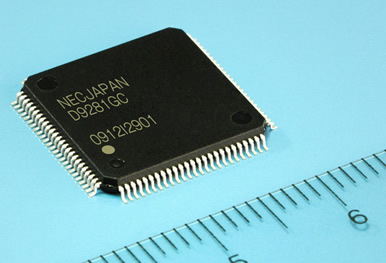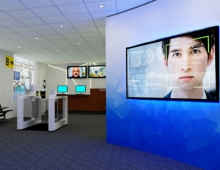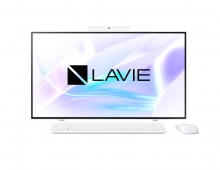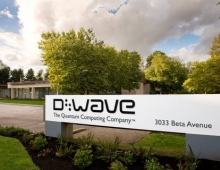
NEC Introduces Super-Resolution ASSP with LVDS Interface for Digital TVs and PC Monitors
NEC Electronics today announced its new super-resolution application-specific standard product (ASSP), the µPD9281GC.
The ASSP addresses the divergence between yesterday's image resolution and the high resolution of today's audio-visual (AV) display systems, and supports the low-voltage differential signaling (LVDS) interface, a technology extensively adopted in broad ranges of flat panel displays, projectors for digital TVs (DTVs) and PC monitors.
 For recent models of flat panel displays and projectors, higher screen resolution is essential to the specification of products with premium display quality. However, the rapid development of today's high-performance digital audio/visual (AV) devices has left consumers with the challenge of how to view low-resolution images on their new high-definition (HD) electronic products. For example, 1920 x 1080-pixel HD televisions have six times the resolution compared to the 720 x 480-pixel standard definition (SD) image data, which results in blurred images. Although many image-enhancement technologies have been developed to process low-resolution image data into full HD images, designers, using traditional solutions, require large-capacity external memory devices and high-performance computational engines, as well as facing other challenges, to achieve real-time processing for vivid moving images.
For recent models of flat panel displays and projectors, higher screen resolution is essential to the specification of products with premium display quality. However, the rapid development of today's high-performance digital audio/visual (AV) devices has left consumers with the challenge of how to view low-resolution images on their new high-definition (HD) electronic products. For example, 1920 x 1080-pixel HD televisions have six times the resolution compared to the 720 x 480-pixel standard definition (SD) image data, which results in blurred images. Although many image-enhancement technologies have been developed to process low-resolution image data into full HD images, designers, using traditional solutions, require large-capacity external memory devices and high-performance computational engines, as well as facing other challenges, to achieve real-time processing for vivid moving images.
To solve these problems, NEC Electronics and NEC Central Research Laboratories jointly developed a new technology that enables very high-resolution processing with just one frame of image data. NEC Electronics has been releasing super-resolution ASSPs based on this new technology since November 2008. The company has named its super-resolution ASSP lineup the "NeoClearResolution (Bikaizo)" and now offers the new µPD9281GC NeoClearResolution ASSP with LVDS interface.
Three key features of the µPD9281GC NeoClearResolution ASSP are:
(1) Supports the LVDS flat panel display interface
With -an integrated LVDS-interface (Note) circuit that connects the flat panel display and the image data processing circuits, NEC Electronics' new ASSP reduces external components and saves space on system boards.
(2) Reduces "mosquito noise" caused by JPEG and MPEG compressed images
The new ASSP integrates a noise-reduction feature to reduce mosquito noise unique to compressed video images of MPEG2, widely used for digital media such as DVDs and Blu-ray discs, and H.264 used for viewing digital satellite broadcasting. The new ASSP also reduces mosquito noise for JPEG compressed images used especially for digital still cameras. Reducing the mosquito noise enables processing of images that are more natural.
(3) Can select area to apply super-resolution
Designers can select up to four specific sections of an image and apply NEC Electronics' super-resolution technology to enhance image quality of those sections. This feature enables the application of the super-resolution technology, such as applying the technology onto a specific area of the picture-in-picture display, which is useful for picture-enhancement demonstrations at consumer electronic stores.
NEC Electronics expects this new ASSP will enable better archiving of valuable images in display devices, and plans to continue developing super-resolution system-on-chips (SoCs) using the NEC Electronics Neo Clear Resolution (Bikaizo) brand name.
Main specifications of NEC Electronics' µPD9281GC super-resolution ASSP can be found here.
Samples of NEC Electronics' µPD9281GC super-resolution ASSP are available now at US$20 each. Mass production is scheduled to begin in February 2010, starting at 100,000 units per month.
 For recent models of flat panel displays and projectors, higher screen resolution is essential to the specification of products with premium display quality. However, the rapid development of today's high-performance digital audio/visual (AV) devices has left consumers with the challenge of how to view low-resolution images on their new high-definition (HD) electronic products. For example, 1920 x 1080-pixel HD televisions have six times the resolution compared to the 720 x 480-pixel standard definition (SD) image data, which results in blurred images. Although many image-enhancement technologies have been developed to process low-resolution image data into full HD images, designers, using traditional solutions, require large-capacity external memory devices and high-performance computational engines, as well as facing other challenges, to achieve real-time processing for vivid moving images.
For recent models of flat panel displays and projectors, higher screen resolution is essential to the specification of products with premium display quality. However, the rapid development of today's high-performance digital audio/visual (AV) devices has left consumers with the challenge of how to view low-resolution images on their new high-definition (HD) electronic products. For example, 1920 x 1080-pixel HD televisions have six times the resolution compared to the 720 x 480-pixel standard definition (SD) image data, which results in blurred images. Although many image-enhancement technologies have been developed to process low-resolution image data into full HD images, designers, using traditional solutions, require large-capacity external memory devices and high-performance computational engines, as well as facing other challenges, to achieve real-time processing for vivid moving images.
To solve these problems, NEC Electronics and NEC Central Research Laboratories jointly developed a new technology that enables very high-resolution processing with just one frame of image data. NEC Electronics has been releasing super-resolution ASSPs based on this new technology since November 2008. The company has named its super-resolution ASSP lineup the "NeoClearResolution (Bikaizo)" and now offers the new µPD9281GC NeoClearResolution ASSP with LVDS interface.
Three key features of the µPD9281GC NeoClearResolution ASSP are:
(1) Supports the LVDS flat panel display interface
With -an integrated LVDS-interface (Note) circuit that connects the flat panel display and the image data processing circuits, NEC Electronics' new ASSP reduces external components and saves space on system boards.
(2) Reduces "mosquito noise" caused by JPEG and MPEG compressed images
The new ASSP integrates a noise-reduction feature to reduce mosquito noise unique to compressed video images of MPEG2, widely used for digital media such as DVDs and Blu-ray discs, and H.264 used for viewing digital satellite broadcasting. The new ASSP also reduces mosquito noise for JPEG compressed images used especially for digital still cameras. Reducing the mosquito noise enables processing of images that are more natural.
(3) Can select area to apply super-resolution
Designers can select up to four specific sections of an image and apply NEC Electronics' super-resolution technology to enhance image quality of those sections. This feature enables the application of the super-resolution technology, such as applying the technology onto a specific area of the picture-in-picture display, which is useful for picture-enhancement demonstrations at consumer electronic stores.
NEC Electronics expects this new ASSP will enable better archiving of valuable images in display devices, and plans to continue developing super-resolution system-on-chips (SoCs) using the NEC Electronics Neo Clear Resolution (Bikaizo) brand name.
Main specifications of NEC Electronics' µPD9281GC super-resolution ASSP can be found here.
Samples of NEC Electronics' µPD9281GC super-resolution ASSP are available now at US$20 each. Mass production is scheduled to begin in February 2010, starting at 100,000 units per month.





















